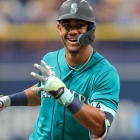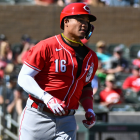Get ready to build a winning team on Draft Day with SportsLine.com's exclusive stats, tools, and projections. Download the Draft Kit with rankings, tiers, auction values, player breakdowns, projections, and more.
Snake drafts are simple, in the sense that you are always tasked with selecting the best player at any given time. True, you may miss out on Mike Trout if you are slotted in the #9 position of a draft, but the procedure is elementary — you choose a player.
In a draft, you may not always want to select the highest valued player available, as I have illustrated using Replacement Level Drafting. You always aim to acquire the player which helps your team the most at the time of your pick. (You can use the Replacement Level Drafting tool here.)
Auctions are my favorite way to draft players. They are more complicated than snake drafts — and I love complicated.
Not unlike a serpentine draft, auctions still require hours of draft preparation to study the players — to figure out which are sleepers, which are busts, etc. In an auction, we also introduce many other aspects such as (but not limited to):
- Budgeting
- Dynamic Valuation
- Game Theory
- Supply / Demand (Economics)
- Patience
These elements aren't listed in any particular order. Some may be performed pre-draft, and some arise as the auction proceeds. All are important to master — if you want to raise a championship banner at the season's end.
Today, I want to discuss with you how to properly execute auction nominations. This is entirely a discourse for an in-auction mechanism. This dialogue will help you execute the most profitable auction, with the goal of accumulating the most player value for the least amount of money spent.
Check out Ariel's guide to developing your own auction values here, and download SportsLine's.
Should You Nominate Your Favorite Players?
At a Fantasy auction, teams take turns tossing out player names for nomination. Any player can be acquired at any time in the auction. Upon your turn — you have the honor and advantage of deciding the following player to be procured.
People often ask the question –
"Should you nominate players you want, or players you don't want at the auction?"
That is a great question.
Some will say (like Joe Pisapia), that you always want to nominate players who you don't particularly want to buy. The idea is to get as much money off the board early on. If you do, later in the auction everyone else will be cheaper. Teams will have less money, you will be able to get bigger bargains, and you will have an easier ability to buy the players you favor! Nominate expensive and overvalued players early on while people still have money, so that players who do not interest you are purchased for even more!
There are those who say (like Larry Schechter), that you should use your nominations to toss out players who interest you the most. Attempt to roster players that are likely to be profitable (the ones who potentially would have the biggest bargains). If you buy the player, you will have more flexibility to spend elsewhere. If you don't, you will at least know to move on to some Plan B.
I'll give you an example of why it may be good to nominate players that you want early on.
Suppose there are two first baseman whom at your valuations might afford you a bargain:
Position | Player | Ariel's Value | AAV | Bargain |
1B | $20 | $17 | $3 | |
1B | $13 | $8 | $5 |
- AAV is the Average Auction Value – The average price that the player is being purchased for at an auction in 2019.
- Ariel's Value is what my projections say that the player is worth.
- Bargain is the difference between the two.
Joey Votto is clearly the better player, however, drafting Eric Hosmer may potentially provide you with a larger chance to profit.
Suppose Votto is nominated first.
"Joey Votto for 10 dollars," says the team throwing him out.
The bids then come in … Eleven, Twelve, Thirteen, Fourteen, Fifteen and Sixteen. Then there is a lull in the bidding, and the room goes silent.
"Going once," says the auctioneer. "Going twice," he continues …
Now what do you do? According to your projections, Votto would be a $3 bargain if purchased at $17 – exactly at his market AAV. He is a good buy … right?
Maybe. You don't know.
Well it is a good buy, but is it the best buy available for a 1B? Hosmer may potentially be a better bargain that Votto, if things go according to the market AAV.
The fear is, that the bidding for Hosmer will go … Seven, Eight, Nine and Ten. To acquire Hosmer, you would now have to pay Eleven dollars, making Hosmer just a two-dollar bargain … one dollar worse than Votto's. If you don't buy Votto at the $3 discount, you may be stuck with a worse return.
Let's say then that you do buy Votto. Well, if Hosmer can be bought for his AAV of just eight dollars – then you have given up two dollars more of profit.
You don't really know the right way to proceed if Votto is nominated prior to Hosmer.
However, if Hosmer was nominated FIRST, then you would know where you stand with the first base situation and can better gauge how to bid. If the five-dollar bargain, or even a four-dollar bargain is available – you grab it right away! Even at a three-dollar bargain, you still can safely purchase him to earn the $3 return. If the bidding goes any higher, now you can more easily ignore Hosmer, knowing that a $3 bargain for Votto may still be available.
So which philosophy is right? Nominate players you want or players that you don't want?
There are merits to both thoughts, and there are true elements to each approach. I believe that how you handle nominations depends on where you are in the draft, who is left on the draft board, and how your targeted players fit in.
For example, let's say that you have just acquired a top 1B early in the auction — Paul Goldschmidt. Almost every team has more money than you. The player that you should nominate next is … Freddie Freeman. You aren't going to buy him, as he won't fit into your budget. This is now a good time to slow down a bit and get some money off the board.
For this instance, I'd agree with Pisapia. However, for most of the time — I agree more with Schechter — that you need to nominate the players whom you may consider purchasing.
One reason to do so is because of the "Economic Box."
Don't Leave a Player in the Economic Box
Position | Player | Ariel's Value | AAV |
SP | $41 | $43 | |
SP | $40 | $41 | |
SP | $38 | $41 | |
SP | $38 | $39 | |
SP | $29 | $31 | |
SP | $28 | $33 |
Consider the above table of projected auction values, and AAVs from last year (2018). These were the top six starting pitchers according to my projections. It is clear both from my projections, and from the market, that the top four SPs are much stronger than the rest of the pack.
Position | Player | Ariel's Value | AAV |
SP | Clayton Kershaw | $41 | $43 |
SP | Max Scherzer | $40 | $41 |
SP | Corey Kluber | $38 | $41 |
SP | Chris Sale | $38 | $39 |
SP | Noah Syndergaard | $29 | $31 |
SP | Stephen Strasburg | $28 | $33 |
SP | $27 | $30 |
Creating the "tiers" for pitchers roughly gives you the above trenches.
Let's also assume that my target pitcher here is none other than Chris Sale. Perhaps I knew that he was working on a new pitch, or that his velocity was up. Or perhaps he seems like the most affordable player in the top six - the only player with an AAV no greater than $1 above the projected value. Whatever the reason, my goal is to acquire Chris Sale for roughly $39.
Suppose that Kershaw and Scherzer are nominated first. This indeed happened in so many auctions last year. In one auction that I played, Kershaw went for $43, and Scherzer went for $42. Now suppose you are the next team to nominate a player.
Who should you nominate?
Assuming we are nominating a starting pitcher next, let's think about the choices, and the economics surrounding them. Remember again … we want Sale!
Choice #1 – Noah Syndergaard
Position | Player | Ariel's Value | AAV |
SP | Clayton Kershaw | $41 | $43 |
SP | Max Scherzer | $40 | $41 |
SP | Corey Kluber | $38 | $41 |
SP | Chris Sale | $38 | $39 |
SP | Noah Syndergaard | $29 | $31 |
SP | Stephen Strasburg | $28 | $33 |
SP | Carlos Carrasco | $27 | $30 |
If you nominate Syndergaard, there is now more differentiation between Sale/Kluber and the rest of the pack. Consequently, there is now more of a demand for the top tiered starters. There is also less of a supply of 2nd tier pitchers (we could have chosen Strasburg or Carrasco for this example). The economics will tell you, that Chris Sale's market price will go up. We don't want that, if we want to buy him.
Choice #2 – Corey Kluber
Position | Player | Ariel's Value | AAV |
SP | Clayton Kershaw | $41 | $43 |
SP | Max Scherzer | $40 | $41 |
SP | Corey Kluber | $38 | $41 |
SP | Chris Sale | $38 | $39 |
SP | Noah Syndergaard | $29 | $31 |
SP | Stephen Strasburg | $28 | $33 |
SP | Carlos Carrasco | $27 | $30 |
Oh no! If you nominate Kluber, look who is in a box all by himself! Sale is in what I call, the Economic Box. The green sliver completely encompasses Sale and only Sale.
Think about what will happen from an economic standpoint. The supply of elite pitchers is now down to just ONE. The demand for Sale is now at an all-time high, since Fantasy players prefer choosing elite players over others. Sale is the last shiny piece of jewelry dangling at the luxury boutique. Sale's price will skyrocket!
In fact, last year — I was in a league where this occurred, and Sale was then bought for $43 - as much as the #1 pitcher, Clayton Kershaw! As soon as the Economic Box forms around a player, the supply/demand economic factors will cause an artificial inflation of the player's price.
Choice #3 – Chris Sale
Position | Player | Ariel's Value | AAV |
SP | Clayton Kershaw | $41 | $43 |
SP | Max Scherzer | $40 | $41 |
SP | Corey Kluber | $38 | $41 |
SP | Chris Sale | $38 | $39 |
SP | Noah Syndergaard | $29 | $31 |
SP | Stephen Strasburg | $28 | $33 |
SP | Carlos Carrasco | $27 | $30 |
Instead, if you nominate Chris Sale - there is less economic pressure for his price point to rise. Sure, there may be an owner who valuated Sale for $43 and would pay more than you would – but that is true about any player.
When nominating Sale, teams will see that Kluber is still on the board. Fantasy owners who are indifferent to Sale vs. Kluber (those that only want an elite arm, whoever it may be) will know that there will still be one more option afterwards. Of course, the same goes for you — if you miss out on Sale, you could still purchase Kluber.
Now, after Sale is nominated, Kluber finds himself within the Economic Box. Kluber's price will surely rise. If you had purchased Sale with your nomination, you certainly do want that to happen since you won't be buying him.
The key - Do not let your target player come close to the Economic Box. The further the player is from its entry, the fewer economic pressures there will be to alter the underlying pricing.
Had Sale been nominated prior to any other pitcher, you would have the following situation:
Position | Player | Ariel's Value | AAV |
SP | Clayton Kershaw | $41 | $43 |
SP | Max Scherzer | $40 | $41 |
SP | Corey Kluber | $38 | $41 |
SP | Chris Sale | $38 | $39 |
SP | Noah Syndergaard | $29 | $31 |
SP | Stephen Strasburg | $28 | $33 |
SP | Carlos Carrasco | $27 | $30 |
There are no artificial economic pressures in this scenario for the tall lefty. Sale should go for roughly $39, unless one owner complete dissents from the market, which he would have anyways.
How to Use the Economic Box
Don't use it … avoid it! Make sure that none of your targets end up in the Economic Box or even close to it if you can.
Indeed, there are so many things to focus on during an auction. The assignments range from looking up player values to bidding to making sure that your statistics are balanced. Properly nominating players is just as important.
Spend some time during the auction (before your turn approaches) to scan the positional scarcity boards. Look at the list of shortstops and third basemen. Ask yourself: Are any of your targeted players getting close to the Economic Box? Which positions are starting to form the box? Which players are most at risk of their projected bargains disappearing?
Find the positions in which your target players are now (for example) the 3rd highest available value left on the board … and nominate them. Give yourself the best chance of acquiring them with the lowest cost. Then scan again, repeat the process for your next turn, and for all subsequent toss-outs.
On the flip side, if you do not desire the top player available or if you have just purchased a high-priced player, by all means, use your toss-out to get money off the board. Nominate the top player on the board or nominate your undesired players within an Economic Box. Their prices will surely be dialed up, which is what you want.
Whatever course of action you take, be methodical in your auction nominations — because they matter.
















